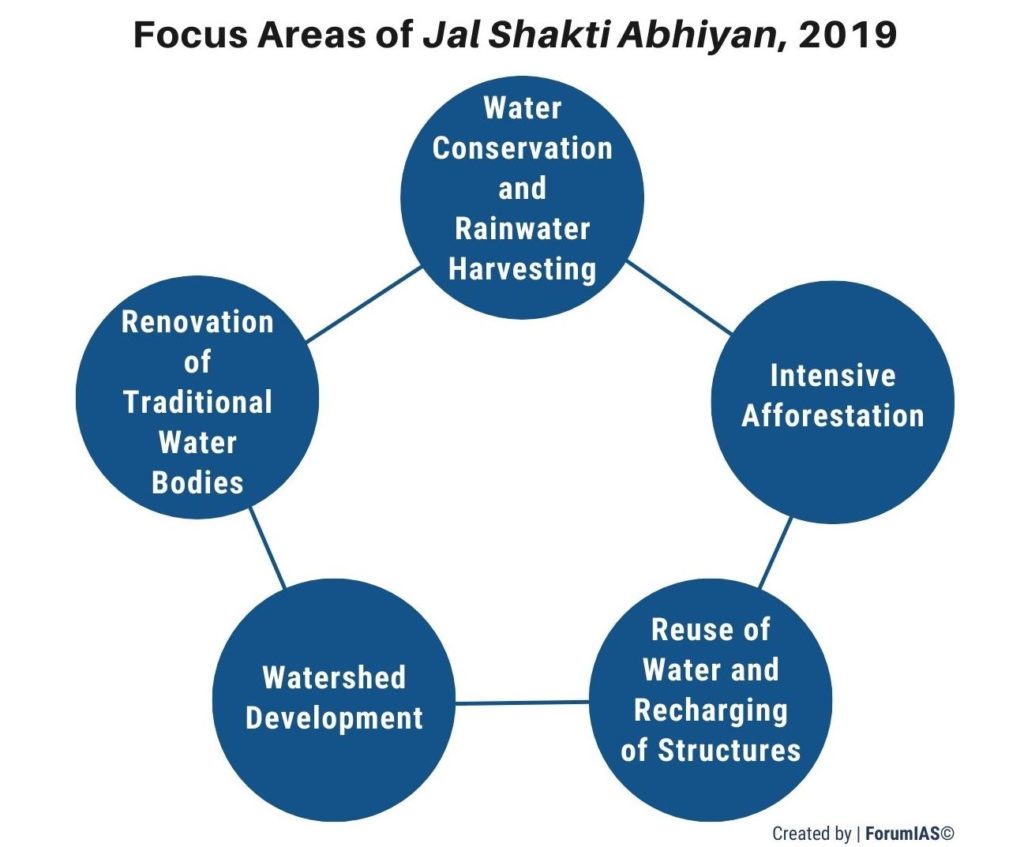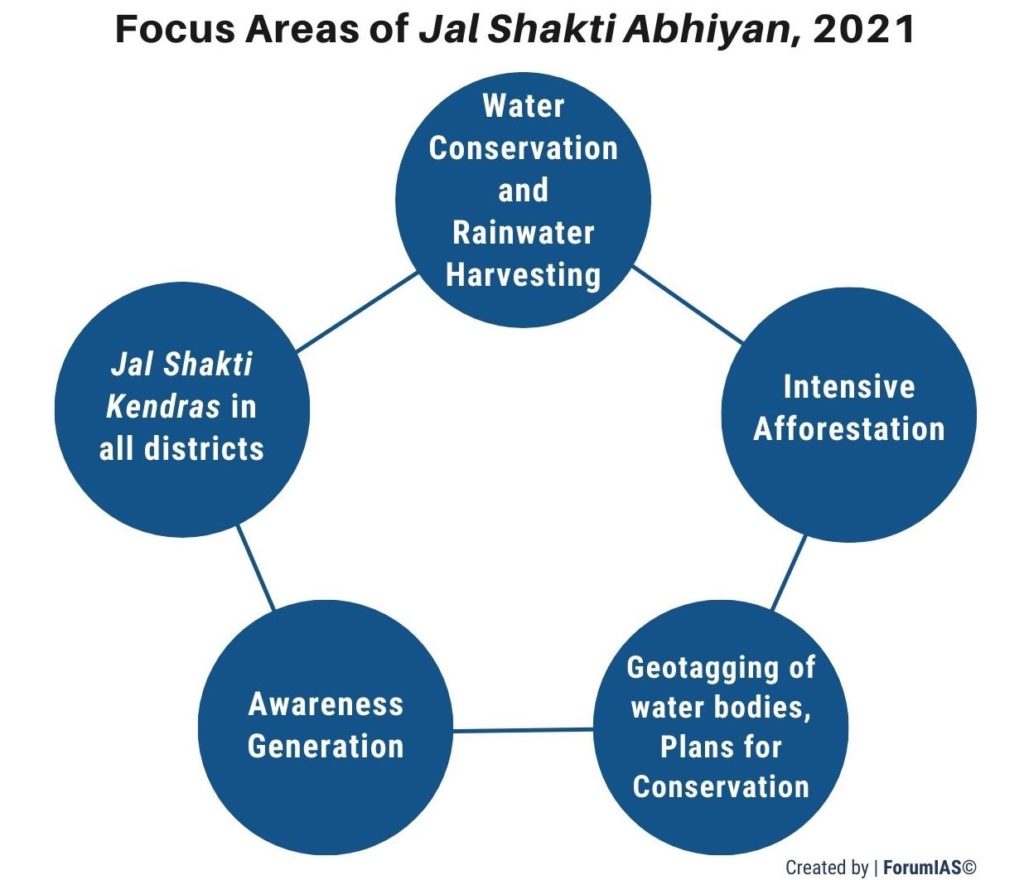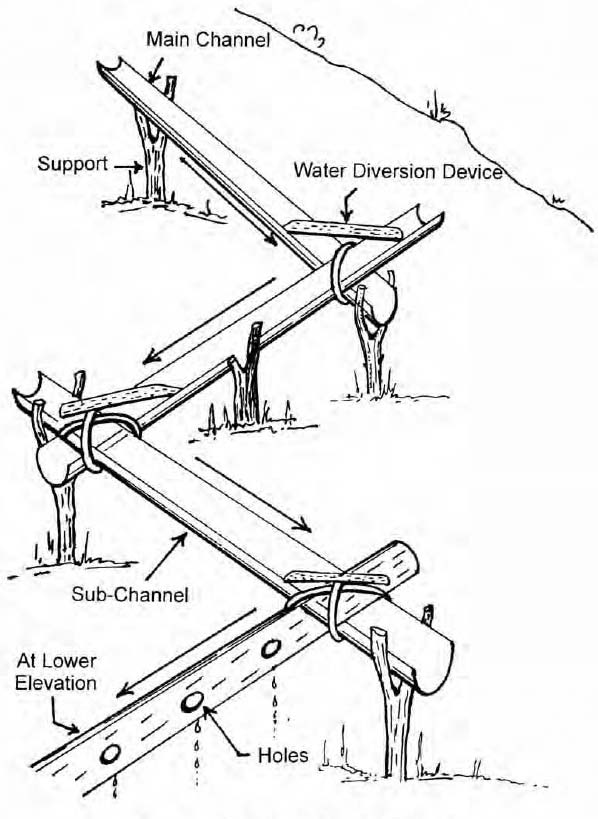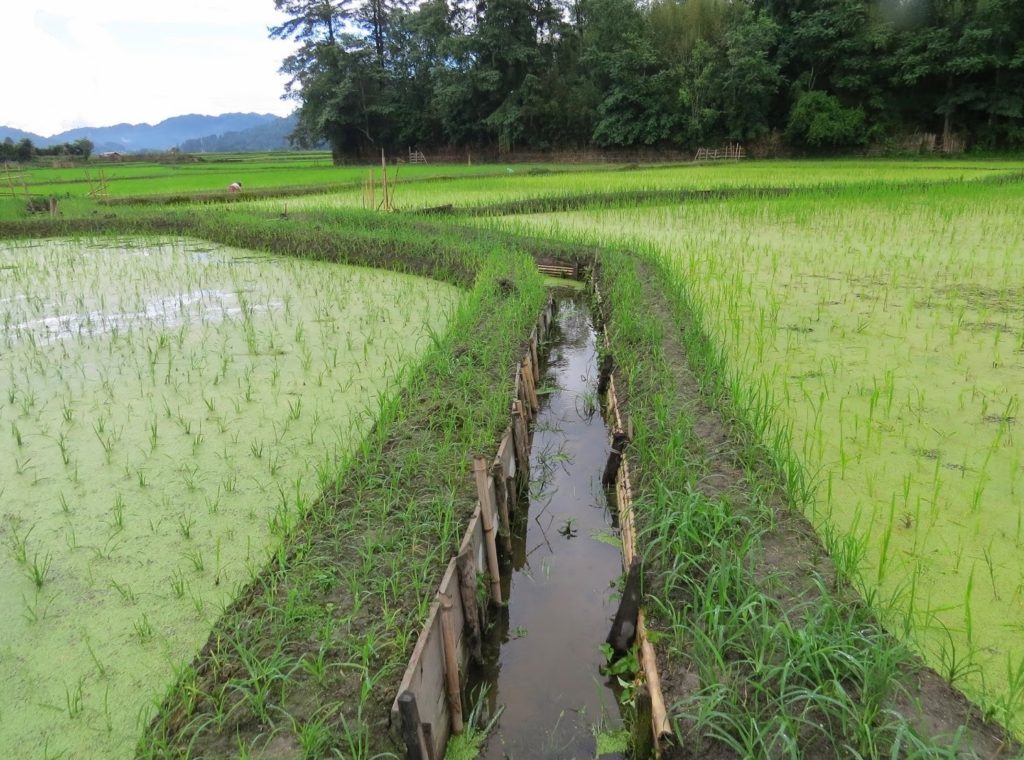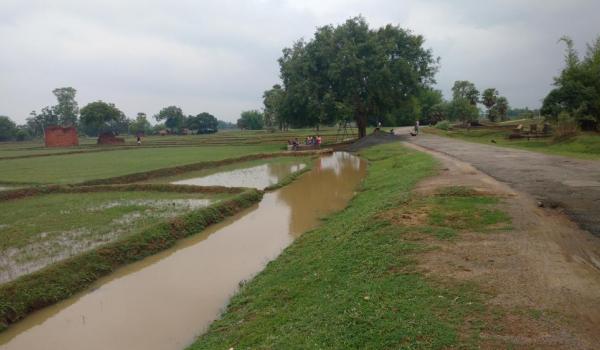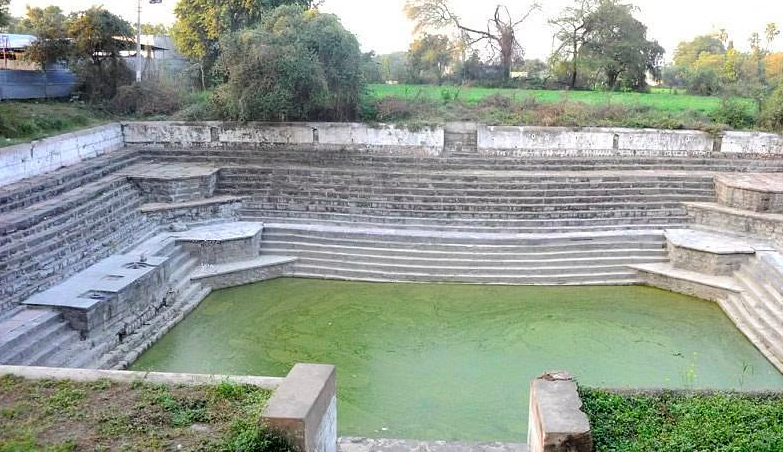ForumIAS announcing GS Foundation Program for UPSC CSE 2025-26 from 19 April. Click Here for more information.
ForumIAS Answer Writing Focus Group (AWFG) for Mains 2024 commencing from 24th June 2024. The Entrance Test for the program will be held on 28th April 2024 at 9 AM. To know more about the program visit: https://forumias.com/blog/awfg2024
Contents
- 1 Introduction
- 2 About the Jal Shakti Abhiyan, 2019
- 3 What are the achievements of Jal Shakti Abhiyan, 2019?
- 4 About the Jal Shakti Abhiyan, 2021
- 5 What are the achievements of Jal Shakti Abhiyan, 2021?
- 6 About Jal Shakti Abhiyan 2022: Catch the Rain
- 7 What are some of the traditional water conservation methods in India?
- 8 How can the revival/protection of water bodies be ensured?
- 9 Conclusion
| For 7PM Editorial Archives click HERE → |
Introduction
Creating water secure communities is at the heart of Government of India’s efforts in the water sector. India is home to 18% of the world’s population but has just 4% of the freshwater resources of the world. This availability is also variable and dependent on the rains. Climate change, which is manifesting itself through changes in the water cycle, also threatens our water security. To address this problem, the Government of India, launched the Jal Shakti Abhiyan (JSA) in 2019. Revamped campaigns were launched in 2021 and 2022 as well. Apart from this, India also possesses a huge repository of traditional knowledge in water conservation that can be leveraged for improving the water situation in the country.
| Read More: Water Crisis in India – Explained, pointwise |
About the Jal Shakti Abhiyan, 2019
This was a time-bound, mission mode water conservation campaign, implemented in the July – November 2019 period in 1,592 blocks of 256 water-stressed districts of the country.
These blocks fell under the critical or over-exploited groundwater category, where groundwater was being extracted faster than it could be replenished. It was a collaborative effort of various ministries of the Government of India and state governments, coordinated by the Department of Drinking Water and Sanitation, Ministry of Jal Shakti.
It aimed at making water conservation a jan andolan through extensive communication and involvement of communities.
Besides, the special interventions included development of Block and District Water Conservation Plans, Krishi Vigyan Kendra Melas, Urban Waste Water Reuse and 3D Contour Mapping of all villages.
What are the achievements of Jal Shakti Abhiyan, 2019?
The combined efforts of all stakeholders achieved: (a) Creation of 2.73 lakh water conservation and rainwater harvesting structures; (b) Renovation of 45000 water bodies/ tanks; (c) Creation of 1.43 lakh reuse and recharge structures; (d) 1.59 lakh watershed development related works; (e) 12.36 crore trees planted and preparation of 1372 block water conservation plans.
Beyond these numbers, the campaign created a strong environment for bringing together all stakeholders working on water recharge and management.
Many States did more than that was originally planned. Some states extended the campaign to all their districts, going beyond the water-stressed districts that were selected initially.
About the Jal Shakti Abhiyan, 2021
‘Jal Shakti Abhiyan: Catch The Rain Campaign‘ was taken up in all 734 districts (7213 rural blocks and all urban areas) of the country during the pre-monsoon and monsoon period, i.e. from March 2021 to 30 November 2021.
The aim was to ‘nudge the States and stakeholders to create and maintain appropriate Rain Water Conservation Structures, suitable to the soil strata and climatic conditions of the area with people’s participation. The structures were to be created before the onset of monsoons so that they are ready to catch the rain, where it falls, when it falls‘.
This unique campaign converged funds of all water conservation related schemes (MGNREGS, AMRUT, CAMPA Funds, etc) of central and state governments, funds mobilized locally and from corporate sectors.
The campaign implemented by National Water Mission (NWM), had the following five focused interventions:
National Water Mission, with the help of NIC, developed a portal (http://jsactr.mowrgov. in) for monitoring the progress of the campaign.
What are the achievements of Jal Shakti Abhiyan, 2021?
The degree of progress since the launch on 22 March 2021 till 28 March 2022, both urban and rural areas put together: (a) 10,69,649 water conservation and rainwater harvesting structures have been completed while 5,58,028 works are on-going thus totalling to 16,27,677 water harvesting structures; (b) 1,79,950 traditional water bodies have been renovated while 1,17,716 works are on-going; (c) 8,32,596 reuse and recharge structures were created/ getting made; (d) 19,18,913 watershed development activities have been undertaken/going-on; (e) 36,76,60,580 afforestation activities carried out under the campaign; (f)374 Jai Shakti Kendras were set up in various States/UTs; (g) 15.32 lakh water bodies have been enumerated with its details like its latitude and longitude, ownership, state of health, photos, etc under the campaign.
Awareness Generation: Nehru Yuva Kendra Sangathan (NYKS) and its youth clubs have engaged over 2.90 crore people in the campaign. They undertook various activities like rallies, Jal Choupals, quizzes, debates, slogan writing competitions, wall writings etc..
IEC Materials: The mission got information, education and communication (IEC) materials developed in regional languages on water harvesting and conservation by professional agencies. It was then uploaded on the official website of NWM for the use of stakeholders.
About Jal Shakti Abhiyan 2022: Catch the Rain
It is being taken up in all districts (rural as well as urban areas) of the country with the main theme Catch the Rain, where it falls, when it falls. The campaign is being implemented from 29 March 2022 to 30 November, 2022 – the pre-monsoon and monsoon period in the country.
Under this campaign activities are also undertaken under the following new interventions along with previous activities of the 2021 campaign. This includes: (a) Spring Shed Development and Management; (b) Wetland Development and Management; (c) Catchment area protection and development.
Amrit Sarovars: 75 water bodies will be created/ rejuvenated in every district under the campaign as India celebrates 75 years of independence.
Visit of Central Team to the Districts: It is proposed to send a Central Team consisting of one Central Nodal Officer (CNO) and one Technical Officer for one field visit to the districts during the campaign. They will interact with district authorities on Jal Shakti Abhiyan.
| Read More: [Kurukshetra July Summary] Equitable Water Resources Management – Explained, pointwise |
What are some of the traditional water conservation methods in India?
North East India
Bamboo Pipes: In this simple method, water is transported through bamboo pipes for irrigation. Bamboo pipes are used to divert water of springs on the hilltops to the lower regions by gravity.
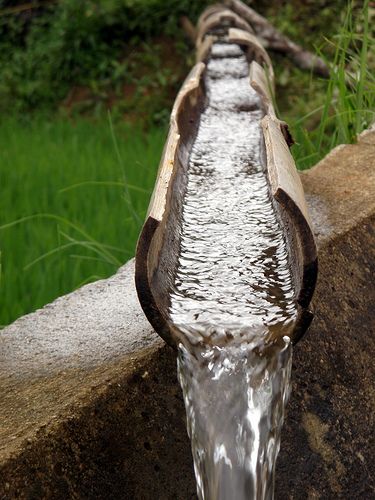
Source: Permaculture Research Institute
Apatani: It is a wet rice cultivation cum fish farming system practiced in elevated hilly regions and gentle sloping valleys of Northeast India. Apatani can tap the water of small streams and springs in these high rainfall hilly regions through their temporary walls. These walls act as barriers and can divert the flow of water towards terraced and valley lands.
Source: C.P.R. Environmental Education Centre, Chennai; Ministry of Environment
Indo Gangetic Plains
Ahar–Pyne: It is a traditional floodwater harvesting system prevalent in Bihar. Ideal terrain for Ahar-pyne should have an evident slope, sandy soil, low groundwater level and flood during monsoon.
Source: C.P.R. Environmental Education Centre, Chennai; Ministry of Environment
Rajasthan, Gujarat and the Western Deserts
Kunds or Kundis: In western arid areas of Rajasthan, kunds are water-harvesting structures. They have a saucer-shaped catchment area that gently slopes towards the centre where the well is situated. A wire mesh across water-inlets prevents debris from falling into the well pit. The sides of the well-pit are generally covered with lime and ash.
Source: C.P.R. Environmental Education Centre, Chennai; Ministry of Environment
Nadis: It is the local name of a village pond used for storing rainwater from the adjoining natural catchment areas. These were very common in Jodhpur.
Source: C.P.R. Environmental Education Centre, Chennai; Ministry of Environment
South India
Eri and Kulams: Tamil Nadu has no perennial river that can cover the whole state. This inspired people to use monsoon rains for irrigation and filling the ponds for consumption and other purposes. It has been mentioned that approximately one-third of the irrigated area of Tamil Nadu is watered by the Eris (tanks). Eri is the name given to a broad irrigation tank while Kulam is a small pond located close to a temple. Eris are used for cultivation, and Kulam for drinking water purpose.
Source: Indiawaterportal.org
Deccan and Maharashtra
Kohli Tank: They are called so because of the name of a group of cultivators who built these tanks three centuries back. A network of channels to practically carry water to every house was in existence in the Bhandara district of Maharashtra. The tanks were built on the slopes of the Gaikhuri range
How can the revival/protection of water bodies be ensured?
Focus should be on sustainability. Therefore emphasis should be on long-term goals, operation and maintenance, adequate budget, and ownership and responsibility to the people.
Economic, environmental and social impact of the project should be studied in detail beforehand and reviewed in between for the course correction. Local communities need to be involved in all these planning and reviews.
Encouraging local people to collaborate with other stakeholders to successfully utilize resources should be done to ensure the protection and conservation of water bodies.
Conclusion
The focused approach of the Government through Jal Shakti Abhiyan is yielding positive outcomes. However, given the magnitude of water crisis and the possible exacerbation due to climate change, a relentless effort is required. Addressing the water crisis will require mass participation at a pan India level. Thus, the Government must redouble its endeavours towards water conservation and awareness generation.
Syllabus: GS III, Conservation
Source: Kurukshetra July 2022, CPR Environment Education Center

